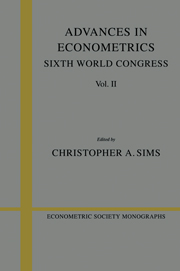6 - Econometric analysis of representative agent intertemporal asset pricing models
Published online by Cambridge University Press: 05 January 2013
Summary
INTRODUCTION
This chapter attempts to augment and critique recent econometric work on the relations between aggregate consumptions and equilibrium asset prices. The increased interest in the econometric implications of intertemporal asset pricing relations during the past decade can be traced to several important developments in economic theory and econometric method. In the latter half of the 1970s, Rubinstein (1974, 1976), Cox, Ingersoll and Ross (1985), Lucas (1978) and Breeden (1979) deduced general equilibrium relations between consumption decisions and asset prices under the assumptions that agents had common information sets, access to a complete set of contingent claims markets, identical preferences and equal access to all production technologies. These models served to significantly expand our understanding of the characteristics of asset prices and the nature of hedging demands in dynamic, stochastic models.
However, the implied asset pricing relations were typically highly nonlinear and not easily analysed with existing econometric techniques. Not surprisingly, then, early empirical studies explored the properties of several very special cases of these models. Hall (1978), Sargent (1978) and Flavin (1981), as well as many others subsequently, investigated versions of the permanent income-life-cycle model of consumption. Preferences were assumed to be quadratic and constraints were assumed to be linear. These assumptions imply that interest rates on discount bonds are constants and that consumption follows a random walk. Empirical studies of the permanent income model have typically not supported the random walk implication, and the implication of constant real interest rates is also counterfactual.
- Type
- Chapter
- Information
- Advances in EconometricsSixth World Congress, pp. 277 - 312Publisher: Cambridge University PressPrint publication year: 1994
- 2
- Cited by

